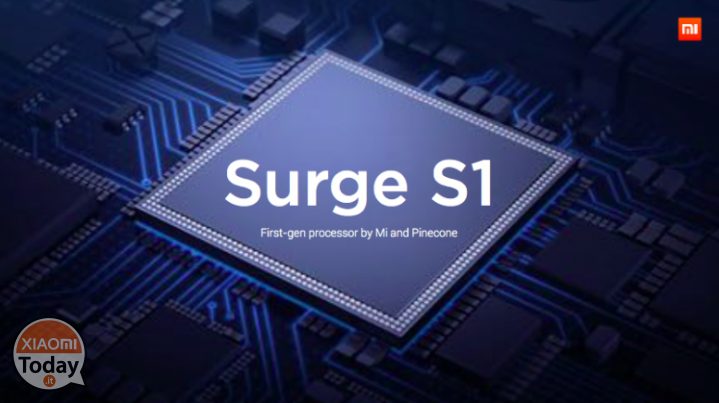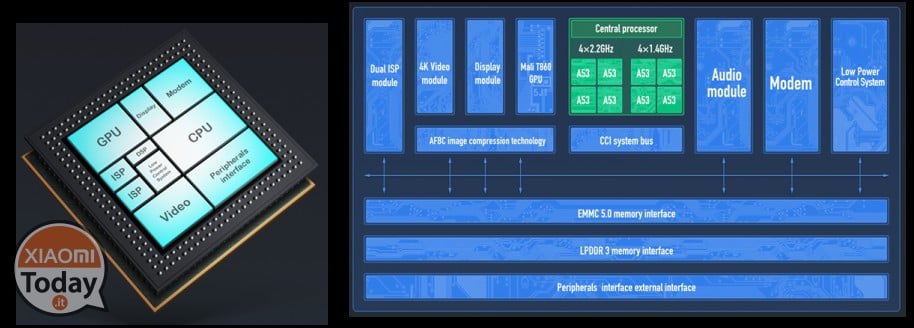
The brand new SoC Xiaomi Surge S1 is already talking a lot about itself and what its performance "on the field" can be, so this small comparison with its rivals can help us understand roughly what the final result will be. Xiaomi has declared that its processor ranks among the mid-level ones, in which we find for example the Qualcomm processor, Snapdragon 625, the SoC Mediatek Helio P25 and finally the proprietary chip of the rival Huawei, Kirin 655.


From a technical point of view the above data can be scary and seem like an unknown language, but it really takes poco to get a clear idea of the data at our disposal: let's start with the CPU: the Surge S1 is an octacore processor, with a 4 × 4 architecture, but the cores do not all work at the same frequency as for the SD 625 or the Helio P25 , and the 4 smallest cores are responsible for performance and power consumption.
In the second row of the table above we find the "feature size", which shows the physical transistor size that regulates power consumption and possible energy dispersion: a high number of nm (nanometers) indicates a recent construction: note the 14nm of Snapdragon 625 or even 10 expected 835nm. Obviously we could not expect a very low figure, but we certainly expected better.
Below we find the results provided by Xiaomi for GeekBench tests - results that were leaked a few days before the official presentation and we talked about it , promising - bearing in mind that the Helio P25 is a reinterpretation of the Helio P20 shown in the slide:

Speaking of graphics processors, Xiaomi unquestionably ranks in first place, thanks to the presence of the Mali-T880 MP4, processor with a quadcore configuration, because the Mediatek chip is only dual core, while the performance of the Kirin is certainly lower. Unfortunately, however, the Mali-T880 MP4 loses when compared with the Adreno 506 of the Snapdragon 625, which was also publicly declared by Xiaomi at the conference: the Surge S1 can only provide half the performance demonstrated by the Adreno chip.
From the RAM point of view, Surge S1 supports dual-channel memory at 32bit as two other chips in the table, with the exception of MTK P25 that supports LPDDR4X memory and for this it offers faster data transmission and the same time a lower energy consumption. However, LPDDNUMX memory is sufficient to ensure good performance for fast loading apps, but may not fully satisfy users who watch HD video or rather heavy games.
In terms of DSP (Digital Signal Processor), a processor that in use in telephony deals with the compression and reproduction of data and voice flow, it can be said that Xiaomi has opted for a 32bit construction that allows a voice in HD, the VoLTE technology for an improvement in quality of voice calls thanks to the wide reserved bandwidth and a double microphone for noise reduction.

How does S1 behave in relation to camera-camera competition? Here Xiaomi has the great advantage of personalization and so S1 is characterized by the dual ISP processor at 14bit which translates into improved image processing and processing capability. In theory, the dual processor also supports dual cameras, in addition to color depth 14bit processing, a dual noise reduction algorithm, and a 150% improvement in light sensitivity. Even the remaining rivals support the dual camera but the Surge S1 is compatible with cameras up to 36MP.

In conclusion, it seems that this is a really mid-range processor, excellent for taking pictures and videos, but with many uncertainties from the point of view of consumption, which certainly, given Xiaomi's investment capacity in research and innovation, marks the way for future developments, even if the Mi 5C remains a really nice, thin and very handy terminal.
And you, are you tempted to try this new processor?








